Archive \ Volume.11 2020 Issue 1
Analysis of Intragroup Preferences of Patients of Far Eastern Federal District in Purchase of Antihypertensive Preparations
Soboleva Mariia Sergeevna 1*, Loskutova Ekaterina Efimovna 2, Voronirovich Igor Vladimirivich 2
1 The Far-Eastern State Medical University, Khabarovsk, 35, Muravyev-Amursky St., 680000, Russia.
2 Peoples' Friendship University of Russia medical faculty, Moscow, 8, Mikluho-MaklayaSt., 11719,Russia.

Abstract
Arterial hypertension is one of the most common chronic diseases. Regular blood pressure control to reach the target level is considered as the main way to reduce the risk of developing cardiovascular complications. Therapeutic classes, which are used as first-line drugs include calcium channel blockers (CCB), β-blockers, diuretics, angiotensin II receptor blockers (ARBs), and angiotensin-converting enzyme (ACE) inhibitors. The aim of the study is to analyze the intra-group preferences of the patients of the Far Eastern Federal District (FSD) when purchasing the five main classes of antihypertensive drugs. Materials and methods: DDD-analysis (162 pharmacy organizations), marketing analysis (share of realization), and statistical analysis (criteria of Kruskal-Wallis, and Spearman) were carried out. Results: The most acquired antihypertensive drugs in the therapeutic class of β-blockers is bisoprolol; among CCB is amlodipine; among the group of diuretics is indapamide; in the ARBs class are losartan and valsartan; and among the ACE inhibitors are enalapril and lisinopril. There are no statistically reliable differences in the structure of the purchase of drugs between the subjects of the FSD. Conclusion: The obtained data prove the unity of the approaches in carrying out drug therapy of arterial hypertension in ten subjects of FSD, and accordingly the full introduction of the guideline into functioning regional health systems. Scientific contribution: Research planning, DDD analysis, marketing analysis, statistical analysis, interpretation and generalization of the obtained data were carried out by the authors. Field of application: The results of this study can be used to assess the compliance of medical care with the current standards, as well as to plan the procurement of antihypertensive drugs for state and municipal needs to optimize the assortment matrix in pharmacy organizations. Future research may conduct a comparative analysis of the structure of antihypertensive drugs acquisition by patients of densely populated western and central regions with the subjects of the FSD.
Keywords: pharmaceutical market, arterial hypertension, drugs, Far Eastern Federal District, sales share, β-blockers, calcium channel blockers, diuretics, angiotensin II receptor blockers, angiotensin-converting enzyme inhibitors

INTRODUCTION
Arterial hypertension (AH) is one of the most common cardiological diseases among the population of the Russian Federation. In general, the regions of the Far Eastern Federal District (FSD) are characterized by higher rates of morbidity than the average in the Russian Federation per 100,000 population [1] (Figure 1). In 8 regions of the FSD, the incidence of AH is higher than all-Russian, which is complicated by the significant geographical distance of administrative centers from other cities and towns, and accordingly by possible difficulties in obtaining specialized medical care. According to the clinical guidelines for the Diagnosis and Treatment of Arterial Hypertension of the Russian Medical Society for Arterial Hypertension, the main goal of AH therapy is to reduce the risk of complications including fatal and non-fatal cardiovascular diseases, cerebrovascular diseases, and chronic kidney disease [2]. The most important way to achieve this goal is to reduce blood pressure to the target values < 140/90 [3-9].
The main tool for the treatment of AН is the regular use of drugs. Most current guidelines identify five main pharmacological groups as starting therapy agents: Angiotensin-converting enzyme (ACE) inhibitors (АСЕ inhibitors), angiotensin II receptor blockers (ARBs), calcium channel blockers (CCB), diuretics, and β-blockers [10-16]. The use of drugs is possible in the form of monocomponent preparations and fixed-doses combinations [17-19]. However, based on a patient’s state of health and individual characteristics, the physician primarily carries out the selection of a specific therapy regimen [20-24].
The full implementation of guidelines in the currently functioning health care system in a particular constituent region of the Russian Federation can be significantly influenced not only by the level of morbidity, but also by the preferences of specialists, as well as by the range of drugs presented on the pharmaceutical market. Therefore, the purpose of this study is to compare the intra-group preferences of the patients of the Far Eastern Federal District when acquisition of antihypertensive drugs. It is in fact aimed at pharmacoepidemiological analysis of the acquisition of five main therapeutic classes of antihypertensive drugs (AHD) (CCB, β-blockers, ARBs, diuretics, ACE inhibitors) in 10 regions of FSD. Statistical analysis of the equality of distribution of indicators of realization of international nonproprietary names (INN) of AHD in the regions of FSD was carried out.
MATERIALS AND METHODS
Data of 2018 concerning the sale of antihypertensive drugs in pharmacy organizations were used for the analysis (n = 162) in Kamchatsky Krai (KK) (n = 6), Magadan region (MR) (n = 2), Khabarovsky Krai (KHK) (n = 66), Sakhalin region (SR) (n = 24), Primorsky Krai (PC) (n = 32), Republic of Saha (Yakutia) (RS) (n = 11), Jewish Autonomous region (JAR) (n = 3), Amur region (AR) (n = 10), Republic of Buryatia (RB) (n = 3), and Zabaykalsky Krai (ZK) (n = 5). Based on the obtained data, a general sales database in natural equivalent (by number of packages) was created using Microsoft Office Excel 2015. The injection medicines, medicines which are on the piece account (clonidine) and also medicines used for medicaments therapy of pulmonary hypertension were excluded from the list (bosentan, macitentanum, riociguat, etc.). The next step was to calculate the total sales of the defined daily doses (DDD) of all international nonproprietary names (INN), based on the data available on the World Health Organization website [25]. The proportion of each drug in the overall realization structure was then calculated. Data Analysis and Subtotals were used. Statistical analysis of the data was performed using IBM SPSS Statistics 25 software (Russian-language version) using the non-parametric Kruskel-Wallis criteria, as well as the Spearman correlation coefficient and factor analysis. The null hypothesis about median equality was rejected at p < 0.05. The correlation was considered significant at p < 0.05.
RESULTS AND DISCUSSION
The structure of the patients' acquisition of drugs in the therapeutic class of CCВ is shown in Figure 2. The leader of the group in 2018 was INN amlodipine. Minimum sales indicators (9%) were observed in the Magadan region, which can be explained by the increase in patients’ demand for diltiazem, as well as in the Khabarovsk region, probably due to the redistribution of preferences towards the relatively recently registered (2016) lercanidipine. The maximum indicators of amlodipine acquisition in 2018 were observed in the Republic of Saha (Yakutia). More than 90% of the implemented DDD in the given therapeutic group was from this INN. The second most frequent acquisition of INN patients was nifedipine, the share of its sales in most studied regions varies within 1%. The results obtained correspond to modern standards and recommendations on drug therapy of AH. The use of the drug once a day may be one of the factors for increasing patients’ compliance.
The acquisition structure of β-blocers in the regions of FSD is shown in Figure 3. The leader of the therapeutic group in 2018 was bisoprolol. Minimum acquisition indicators (6%) were observed in Magadan region, Sakhalin region, Amur region and Zabaykalsky Krai, which can be explained by more frequent acquisition of sotalol - a drug with high anti-arrhythmic activity. The low demand of patients for atenolol and propranolol can be explained by the low selectivity of the preparations and, accordingly, the high risk of developing side effects. Minor sales of nebivolol seem to be due to the high cost of most trading names (more than 200 Rubles- 7.7 USD). The maximum sales indicators of metoprolol (3%) were observed in Sakhalin region and the Republic of Saha (Yakutia), the shares of realization of this INN did not vary significantly among the subjects of the FSD. High demand for bisoprolol can be explained by convenience of application 1 once a day and abundance of trade names in all price segments (from 85 Rubles- 1.3 USD).
The structure of drug sales in the therapeutic class of angiotensin II receptor blockers is shown in Figure 4. The leader of the group in all subjects except the Jewish autonomous region, was lozartan. The maximum indicators of acquisition in 2018 were 10.6% in Kamchatksky Krai and 10.7% in Magadan region. Valsartan was another representative of this group, most frequently purchased by patients of FSD. The maximum shares of sales were observed in JAR 7.9%, due to intra-group redistribution of preferences and low indicators of losartan. The demand for other INH in the angiotensin II receptor blocker group was insignificant (less than 2.5%). The largest indicators of sales of drugs were azilsartan (up to 1.4% in the Republic of Saha (Yakutia)) and telmisartan (up to 2% in the Zabaykalsky Krai). The high frequency of use of drugs of this therapeutic class can be explained by selectivity of active substances and low risk of developing dry cough in regular use.
The structure of diuretics acquisition is shown in Figure 5. The leader of sales in all subjects of the FSD was indapamide. The data obtained can be explained by the presence of additional vasodilator action. The largest shares of acquisition were observed in Magadan region (13.7%), and the minimum indicators (6.45%) in the Republic of Saha (Yakutia). High demand for loop diuretic furosemide was observed in Sakhalin region (2.9%), Magadan region (2.3%), despite strong diuretic effect and high risk of development of side reactions and disorders of electrolytic composition of blood plasma, as well as presence of torasemide on the pharmaceutical market. Acquisition rates of other representatives (hydrochlorothiazide, and eplerenone) were low (1-3%), which may be due to the expansion of the range of fixed-doses combinations in the pharmaceutical market of FSD.
The implementation structure of ACE inhibitors is shown in Figure 6. A wide range of trade names in all price categories (from 10 Rubles- 0.15 USD), possibility of use in the most common combined pathologies (chronic heart failure, and diabetes mellitus), cause the demand of this therapeutic class among patients. The average value of the share of sales in the subjects of FSD is 29.18%. A special feature of the group is the dependence of the leader on a specific region. INN had the largest indicators of implementation in 2018 which include enalapril, lisinopril, and perindopril. Lisinopril was a leader in Kamchatsky Krai (15.2%), Magadan region (19%), Republic of Saha (Yakutia) (12.6%), Amur region (10%), Republic of Buryatia (8.7%) and Zabaykalsky Krai (6.2%). The high demand for this drug can also be explained by the convenience of use 1 once a day and the lack of activation in the liver. Enalapril was the leader in the number of DDD acquired in Khabarovsky Krai (11.5%), Sakhalin region (14%), Primorsky territory (11.1%), Jewish Autonomous region (10.8%) - the most densely populated subjects of FSD, which is probably due to the price availability of trade names. The largest sales figures of the INN perindopril were observed in the Jewish autonomous region (7.1%), and the lowest in the Republic of Buryatia (3.2%). The lyophilic drug captopril was in a considerable demand. The maximum indicators were in the Amur region (4.6%), and the minimum in the Republic of Buryatia (1.86%); while, this drug does not require activation in the liver. Moreover, INN is mainly used not for basic therapy, but for prevention of blood pressure rise and hypertension crisis.
For comparative study of the structure of drug acquisition in different therapeutic classes in all regions, statistical analysis was carried out in the next stage. The null hypothesis was that the equality of distributions in the ten independent selection is comparable. There were no differences in the distribution of patient preferences in the acquisition of antihypertensive drugs (p = 0.993) considering the Kruskal-Wallis criteria at the level of significance of 0.05. Similar results were obtained using factor analysis (correlation was -0.009 at p (one-side) = 0.435). When calculating Spearman’s rank correlation coefficient, the totals were comparable (rs -0.01 0.0040.011; p = 0.935). Based on the obtained data, it can be concluded that the distribution of the structure of acquisition of antihypertensive drugs is similar and there is no significant impact of regional preferences of specialists and patients on the demand in the regions of FSD. There were no differences in the distribution of patient preferences in the acquisition of antihypertensive drugs (p = 0.993) (the Kruskal-Wallis criteria at the 0.05 level of significance). Similar results were obtained by factor analysis (correlation was -0.009 at p (one-side) = 0.435). When calculating spearman's rank correlation coefficient, the totals were comparable (rs -0.01 0.0040.011; p = 0.935). Based on the obtained data, it can be concluded that the distribution of structure of acquisition of antihypertensive drugs is similar and there is no significant impact of regional preferences of specialists and patients on the demand for in the regions of FSD.
CONCLUSION
Based on the data of the study, it can be concluded that the most acquired antihypertensive drugs in ten regions of FSD are amlodipine, bisoprolol, losartan, valsartan, indapamide, lisinopril and enalapril. Differences in intra-group preferences in the regions are not statistically significant, which proves the unity of approaches to drug therapy in the territory of the largest federal district of Russia. One of the practical application of the results of this study can be in detection of compliance of existing recommendations with actual clinical practice and uniformity of its implementation for the most geographically distant regions. The proposed technique can be used for pharmacoepidemiological research not only for FSD, but also for all subjects of the Russian Federation, and the obtained results, in turn, can become predictors of patients’ compliance to therapy prescribed by medical specialists.
Financing
This study did not have any financial support from third parties.
Authors’ contribution
All authors contributed equally to the research work.
Conflict of interests
The authors claim that there is no conflict of interest.
REFERENCES
- Incidence of the population in the Russian Federation 2017. Statistical materials. Part II. Ministry of health of the Russian Federation. Department of health monitoring, analysis and strategic development of FSBU "Central research institute of health organization and informatization" of the Ministry of health of Russia. Moscow, 2018. - P. 90-9 URL: https://www.rosminzdrav.ru/ministry/61/22/stranitsa-979/statisticheskie-i-informatsionnye-materialy/statisticheskiy-sbornik-2017-god (Date of asses 02/11/2019).
- Chazova, Y.V. Zhernakov on behalf of experts Clinical Guidelines. Diagnosis and treatment of arterial hypertension. Systemic hypertension. 2019; 16(1):6-31. doi: 10.26442/2075082X.2019.1.190179.
- Brunstrom M. Carlberg B. Association of blood pressure lowering with mortality and cardiovascular disease across blood pressure levels: a systematic review and meta-analysis. JAMA. 2018; 178: 28–36.
- Ettehad D. Emdin C.A., Kiran A., Anderson S.G. et al. Blood pressure lowering for prevention of cardiovascular disease and death: a systematic review and meta-analysis. Lancet. 2016; 5; 387(10022):957-967. doi: 10.1016/S0140-6736(15)01225-8.
- Slivnick, J., Lampert B.C. Hypertension and heart failure. Heart Fail Clin. 2019; 15(4):531-541. doi: 10.1016/j.hfc.2019.06.007.
- Grassi G., Calhoun D.A., Mancia G., Carey R.M. Resistant hypertension management: comparison of the 2017 American and 2018 European high blood pressure guidelines. Curr Hypertens Rep. 2019; 21(9):67. doi: 10.1007/s11906-019-0974-3.
- Hannah-Shmouni F., Gubbi S., Spence J.D., Stratakis C.A. et al Resistant hypertension: a clinical perspective. Endocrinol Metab Clin North Am. 2019; 48(4):811-828. doi:10.1016/j.ecl.2019.08.010.
- Banga S., Mungee S., Patel A.R., Singh S. et al Management of resistant hypertension based on recommendations from different guidelines and the systolic blood pressure intervention trial. Cureus. 2019; 11(8):5371. doi: 10.7759/cureus.5371.
- Nardin C., Rattazzi M., Pauletto P. Blood pressure variability and therapeutic implications in hypertension and cardiovascular diseases. High Blood Press. Cardiovasc Prev. 2019: Sep 26. doi:10.1007/s40292-019-00339-z.
- James P.A., Oparil S., Carter B.L. et al. 2014 Evidence-based guideline for the management of high blood pressure in adults report from the panel members appointed to the eighth joint national committee (JNC 8). J. Am. Med. Assoc. 2014; 311(5):507-520 doi: 1001/jama.2013.284427.
- Mancia G. Fagard R., Narkiewicz K., Redón J.et al. 2013 ESH/ESC Guidelines for the management of arterial hypertension: the Task Force for the management of arterial hypertension of the European Society of Hypertension (ESH) and of the European Society of Cardiology (ESC). J Hypertens. 2013; 31(7):1281-357. doi: 10.1097/01.hjh.0000431740.32696.cc.
- Flack J.M., Adekola B. Blood pressure and the new ACC/AHA hypertension guidelines. Trends Cardiovasc Med. 2019; May 15:S1050-1738(19)30068-4. doi:: 10.1016/j.tcm.2019.05.003.
- Bundy J.D., Mills K.T., He J. Comparison of the 2017 ACC/AHA hypertension Guideline with earlier guidelines on estimated reductions in cardiovascular disease. Curr Hypertens Rep. 2019; 21(10):76. doi: 10.1007/s11906-019-0980-5.
- Bakris G. Ali W., Parati G. ACC/AHA versus ESC/ESH on Hypertension Guidelines: JACC Guideline Comparison. J Am Coll Cardiol. 2019; 73(23):3018-3026. doi: 10.1016/j.jacc.2019.03.507.
- Vázquez-Narváez K.G. Ulibarri-Vidales M. The patient with hypertension and new guidelines for therapy. Curr Opin Anaesthesiol. 2019; 32(3):421-426. doi: 10.1097/ACO.0000000000000736.
- Larina V.N., Bart B.J., Vartanyan E.A., Fedorov E.V., et al. Approaches to diagnosis and therapeutic tactics of arterial hypertension in light of European recommendations. Cardiology. 2019; 59(9):67-70. https://doi.org/10.18087/cardio.2019.9.n518.
- Thomopoulos C., Parati G., Zanchetti A. Effects of blood pressure-lowering on outcome incidence in hypertension: 5. Head-to-head comparisons of various classes of antihypertensive drugs – overview and meta-analyses. J Hypertens. 2015; 33(7):1321–41. doi: 10.1097/HJH.0000000000000614.
- Suchard M.A., Schuemie M.J., Krumholz H.M.., You S.C. et al Comprehensive comparative effectiveness and safety of first-line antihypertensive drug classes: a systematic, multinational, large-scale analysis. Lancet. 2019: Oct 24:S0140-6736(19)32317-7. doi: 10.1016/S0140-6736(19)32317-7.
- Campbell N.R.C. A step in the global effort to control hypertension: Fixed dose combination antihypertensive drugs.J Clin Hypertens (Greenwich). 2019; 21(9):1426-1428. doi: 10.1111/jch.13683.
- Polychronopoulou E., Burnier M., Wuerzner G. Hypertension in the elderly: have new guidelines changed the management? Rev Med Suisse. 2019; 15(662):1597-1602.
- Lee J.H., Kim K.I., Cho M.C. Current status and therapeutic considerations of hypertension in the elderly. Korean J Intern Med. 2019; 34(4):687-695. doi: 10.3904/kjim.2019.196.
- Morozova T.E., Vartanova O.A., Andreev S.S. Topical issues of choosing antihypertensive drugs. Consilium Medicum. 2016; 18(5):17-
- Avdonina N.G., Korostovtsev L.S., Irtyuga O.B., Zvartau N.E., Konradi A.O. The choice of antihypertensive medicine in special groups of patients: age and gender distinctions. Arterial hypertension. 2014; 20(4):232-237.
- Martsevich, S.Y., Zagrebelny A.V., Lukina Yu..V., et al. Analysis of the practice of using combination therapy with antihypertensive drugs according to the data of two outpatient registers. Russian cardiology journal. 2017; 22 (8):107-113.
- ATC/DDD Index URL: https://www.whocc.no/atc_ddd_index/?code=C (Date of access 31.07.2019).
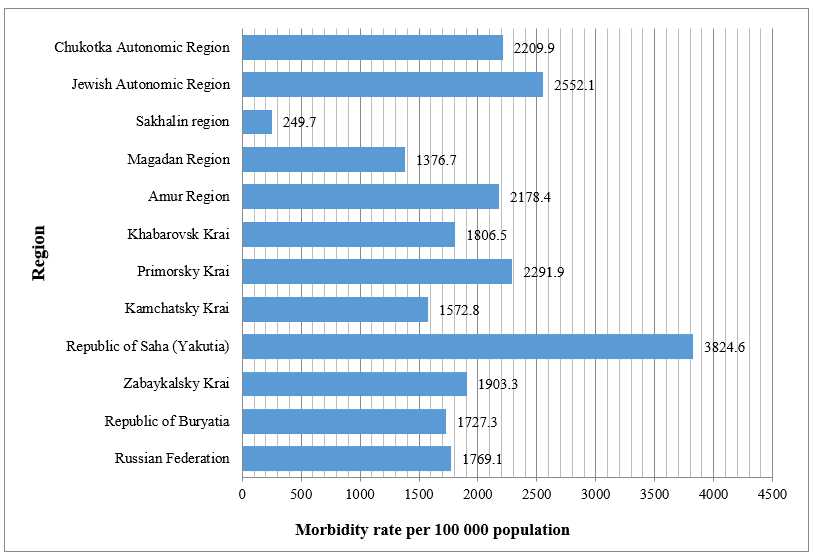
Figure 1 - Morbidity of the population of FSD with essential hypertension in 2017
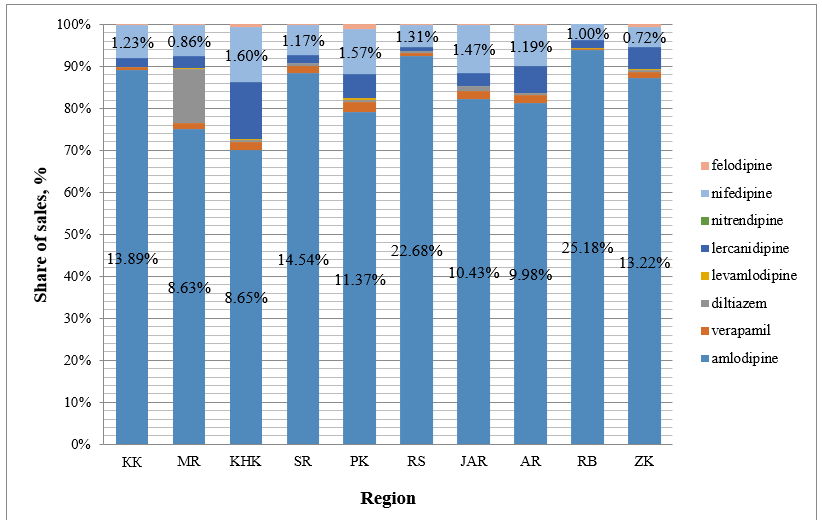
Note: КК - Kamchatsky Krai; МR - Magadan region; KHK - Khabarovsk Krai, SR - Sakhalin region, PК - Primorsky Krai, RS - Republic of Saha (Yakutia); JAR - Jewish autonomic region; АR – Amur region, RB - Republic of Buryatia, ZK- Zabaykalsky Krai
Figure 2 – The structure of acquisition of calcium channel blockers
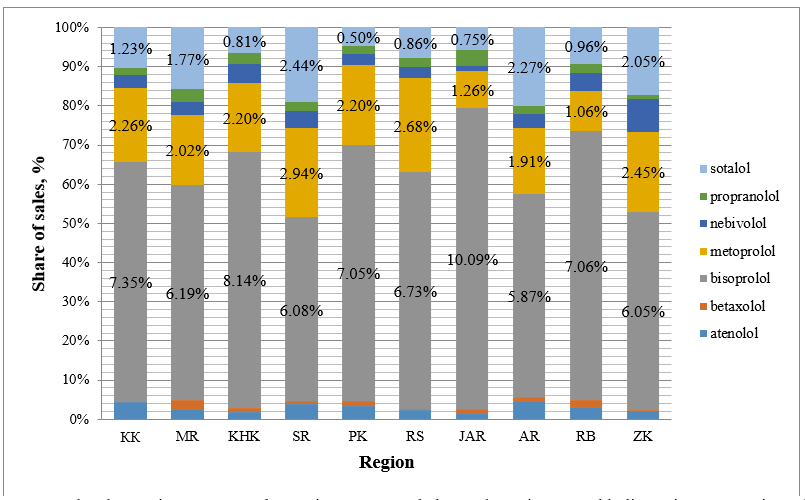
Note: КК - Kamchatsky Krai; МR - Magadan region; KHK - Khabarovsk Krai, SR - Sakhalin region, PК - Primorsky Krai, RS - Republic of Saha (Yakutia); JAR - Jewish autonomic region; АR – Amur region, RB - Republic of Buryatia, ZK- Zabaykalsky Krai
Figure 3 – The structure of acquisition of β-blockers
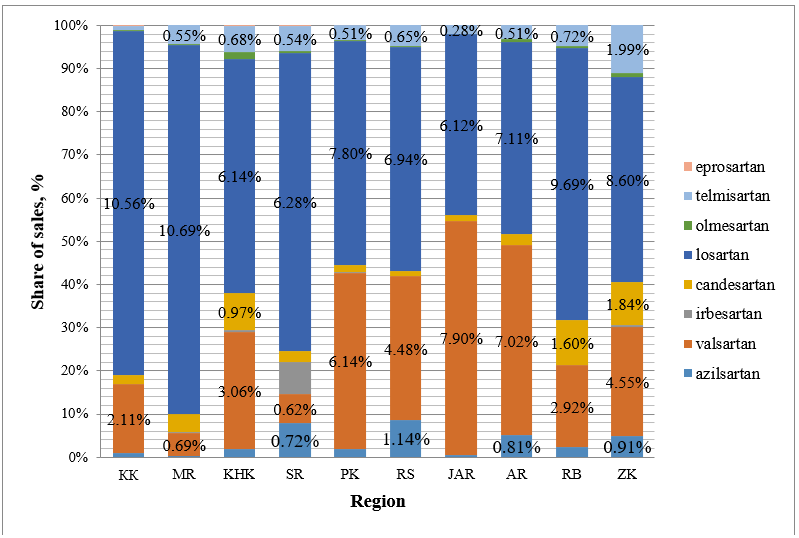
Note: КК - Kamchatsky Krai; МR - Magadan region; KHK - Khabarovsk Krai, SR - Sakhalin region, PК - Primorsky Krai, RS - Republic of Saha (Yakutia); JAR - Jewish autonomic region; АR – Amur region, RB - Republic of Buryatia, ZK- Zabaykalsky Krai
Figure 4 – The structure of acquisition of angiotensin II receptor blockers
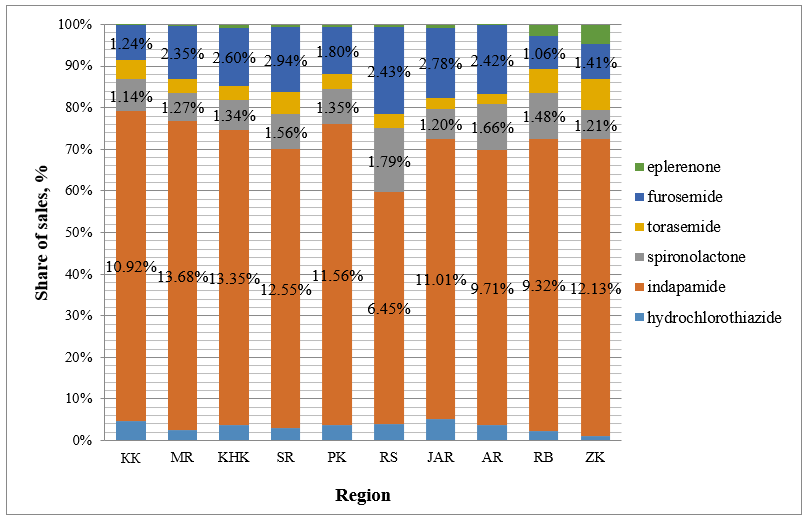
Note: КК - Kamchatsky Krai; МR - Magadan region; KHK - Khabarovsk Krai, SR - Sakhalin region, PК - Primorsky Krai, RS - Republic of Saha (Yakutia); JAR - Jewish autonomic region; АR – Amur region, RB - Republic of Buryatia, ZK- Zabaykalsky Krai
Figure 5 – The structure of acquisition of diuretics
Note: КК - Kamchatsky Krai; МR - Magadan region; KHK - Khabarovsk Krai, SR - Sakhalin region, PК - Primorsky Krai, RS - Republic of Saha (Yakutia); JAR - Jewish autonomic region; АR – Amur region, RB - Republic of Buryatia, ZK- Zabaykalsky Krai
Figure 6 – The structure of acquisition of angiotensin-converting enzyme inhibitors
